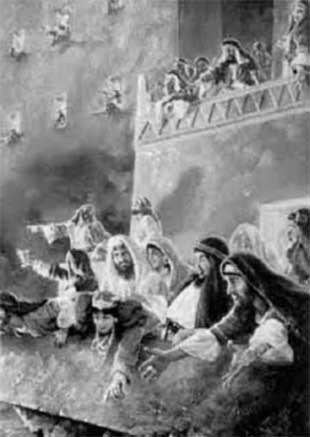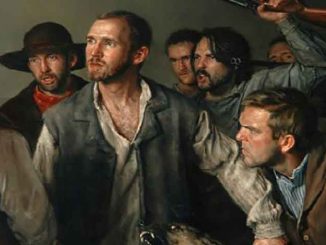

Liquid modernity is a concept that describes a challenge for the saints of the last days. Not so much in our status as church members, but in how to sustain that status in the changing and unpredictable environment where the mammoth task of restoration takes place.
Knowing these changes and how they affect us will help us better understand our fears, uncertainties, and how to live with them.
I will comment, besides the scriptures, some ideas of Zygmunt Bauman in his work «Liquid Modernity», his reflections have helped me to situate myself better in this exciting challenge.
The Parable of Building

The parable of the two builders is found in Matthew 7:24-25 and Luke 6:48-49.
Matthew highlights the one who builds in the sand «a foolish man, which built his house upon the sand: And the rain descended, and the floods came, and the winds blew, and beat upon that house; and it fell: and great was the fall of it.»
Luke best describes «a man which built an house, and digged deep, and laid the foundation on a rock: and when the flood arose, the stream beat vehemently upon that house, and could not shake it: for it was founded upon a rock.»
This parable has an aspect, not only personal, it also speaks to us as a community, of how we build our society, therefore it is also an analogy of the collective work that the peoples do. Hence, in order to be able to glimpse our present and future with precision, we only have to reflect on this parable as Nephi did, from the «science of the Jews» (1) or in our case from the perspective of our time.
The rock
The two most relevant aspects of this parable are the construction site and its requirements. On the one hand, the rocky terrain is compact and shaped, its mineral components are tightly connected and often hidden by a layer of soil.
In order to get to the rock, the sand has to be crossed first, and the sand invites you to stay there and no longer work on a task in an unknown future, further down the road.
To work in that future, you need determination and will. Digging, deepening and grounding are soul processes often used in scripture, requiring maturity and a decision to remain and manage the land, which will then need to be urbanized and perpetuated in time.

The sand
The sandy soil is loose, without form and its components are individual grains. He who builds on it does not ask for an alliance with the rock, his intention is not to remain, because he does not have the will to perpetuate himself in time nor to administer it, his time on it is ephemeral.
We always understand that he who builds on the rock does so on Christ and is right.
However, both builders are not hermits, they do not work in solitude but are part of a geography (our time) and of a community (our society). Therefore this scripture unfolds, as we strive, into deep and extensive meanings applicable to our lives in many ways.
I propose that following these words we reflect on the door that the scriptures open for us to understand our world and that we do so with our science.
The previous geography.
It is difficult to understand our situation as saints in 2017, if we do not look back and compare.
In a manner of speaking, from 1830 onwards, including the beginning of the 20th century, the church of Jesus Christ is built in a rocky environment. That is, at a time when reason prevailed as the rector of human activity (you’ll think and now you won’t?)
In this sense, Bauman calls this period «heavy modernity», suggesting with this definition the epoch in which the great, the heavy, power and accelerated growth predominate. Human activity tends to dominate the oceanic space, to cross continents and to step on virgin spaces that the human foot never knew. In his book «Liquid Modernity» he tells us:
«Heavy modernity was, after all, a time in which reality was shaped in the manner of architecture or gardening; so that reality would adjust to the dictates of reason… It was a time that dreamed of legislating to make reason a norm of reality» (p. 53).
The citizen

That citizen inhabited a solid environment with a law based on solid certainties. These could change places but did not cease to exist. The consistency of the gospel and its doctrine was accompanied by the consistency of the customs and habits of their time.
The school was an extension of parental authority and the teacher an ally. A fault in that place, outside the walls of the home, was transmitted and resounded like a roar in the same refuge of childhood. When we now speak of motivation in education, in heavy modernity, the will and duty (qualities of the one who built on the rock) ruled and both set human action in motion from childhood itself. One project that was naturally and without debate was the creation of a family.
The physics of solids dominated any activity, so there was no uncertainty as to what personal duties were urgent or to what ends our vigor should be directed, since the forms of present or future things were like sculptures that bordered any path undertaken.
Heavy modernity
 Unlike today, in heavy modernity, there was a problem of means, but not with ends, these were clear. Quoting Gerhard Schulze (p. 67) Bauman tells us about the problem of our present «Not knowing what the ends are, instead of the traditional uncertainty caused by the lack of knowledge of the means», this idea is illustrated by the famous phrase of the laboratories «we have found the solution, now we will look for a problem» or the typical question with the new mobile.
Unlike today, in heavy modernity, there was a problem of means, but not with ends, these were clear. Quoting Gerhard Schulze (p. 67) Bauman tells us about the problem of our present «Not knowing what the ends are, instead of the traditional uncertainty caused by the lack of knowledge of the means», this idea is illustrated by the famous phrase of the laboratories «we have found the solution, now we will look for a problem» or the typical question with the new mobile.
The heavy modernity becomes visible in the industrial revolution, at the same time that the restoration begins its course. I see a divine intention to bring his work to light at the right time. I imagine the restoration now and it seems to me that I would have many more problems than those caused by the mobs in Missouri. To build on the rock you need a rocky environment. The character of the pioneers is a clear example of the empire of will over motivation.
At that time the landscape of many nations is filled with immense factories, steel is present as an element of this. Society, together with this feverish activity and astonished by the achievements and business methods, feels the obligation to plan the smallest details on a board. The impression that the citizen receives is that the nature of the society that is being formed is to help him in the challenges of life, illness and the uncertainty of old age. So that rocky ground is the guarantee of its future stability when «…the rain descended, and the floods came, and the winds blew, and beat upon that house;» (2).
The family
The family remained an institution allied with the environment, even though it suffered from the changes. The worker saw in the purposes of the company, an extension of his own and both factory, machinery, management and workforce were obliged to form a lasting union located in the same geographical place.
Similar principles were shared in the church, such as order, hierarchy, norms, committees, objectives, goals. In fact the entrepreneurial language has been very familiar in our leadership meetings and the model of success of that time, similar to ours. With this I want to emphasize that the church sailed in a known environment and that our vision of things, in general, was the current one. The terrain connected with our way of understanding life.
In contrast to this description, let’s look at Lehi’s dream building «And I also cast my eyes round about, and beheld, on the other side of the river of water, a great and spacious building; and it stood as it were in the air, high above the earth.» (3)
This vision is both spiritual and temporal.
The strange building

The strange «levitation» of that great building I do not think was a claim for sale, or to move with the family. Not already built in the sand, but in the air, it represents the opposite of the safe and stable, the opposite of the rock. In fact inside there was a multitude of individuals and no family «… it was filled with people, both old and young, both male and female;» (4) individuals mixed in a dissipated attitude. Unable to build family ties, they nevertheless showed themselves to be linked by a language of rough gestures in their forms and clumsy to describe the subtle movements that occurred near the tree. In fact, they were unable to explain their own world since it was based on extravagance.
Yes, a multitude of lonely grains of sand. For those in the building who for a moment realized their real situation, Bauman offers us an example, this time of passengers on a plane.
Ford

«On the other hand, the passengers of the «light capitalism» aircraft discover with horror that the cockpit is empty and that there is no way to extract from the mysterious black box labeled «autopilot» any information about the fate of the aircraft…» (page 65)
That feeling of vertigo when seeing the empty cabin of the plane or the insecurity in the building, if one takes the trouble to look down and observe an abyss without foundations, are sensations different from those that the saints experienced in 1903 when Henry Ford announced his Ford T.
The very organization of work in his factory was a sort of salvation plan for his workers, who earned $5 a day, that was more than double what was customary at the time.
Bauman details «The fordist factory, the most ambitious model of rationality in the era of heavy modernity, was a face-to-face meeting place, but it was also a kind of marriage – the kind until death separates us – between capital and work».
The familiar terrain
Like one another, marriage and the family were based on a contract in its civil aspect and an agreement in its religious aspect. This compact family terrain certainly limited the freedom of the participants, however, it did not repress any aspiration since outside of these ties, the terrain generally did not propitiate the germination of anything that was not in consonance with the environment. Instead, it provided security and stability, a safe platform, usually for the maturation of children.
With this I say that that time, not without challenges, however everything suggested the adoption of the future without reservations, the future as something desirable and proposed the home as a place for the fulfillment of aspirations.
Tell me, kind readers, can we say that right now?
The straw problem
Bauman presents us with an ancient problem of the people of Israel.
«Ye shall no more give the people straw to make brick, as heretofore: let them go and gather straw for themselves. And the tale of the bricks, which they did make heretofore, ye shall lay upon them; ye shall not diminish ought thereof: for they be idle; therefore they cry, saying, Let us go and sacrifice to our God.» (Exodus 5:7-8)

Today we are faced with a similar problem, the tasks carried out for that heavy reason are increasingly privatised, by the force of the state that built the world. Bauman comments:
«Risks and contradictions continue to be socially produced; the individual is only being burdened with the responsibility and need to face them» (page 40).
The old security in the future has been replaced by uncertainty. Pensions, birth rate, employment, training. I hear with insistence the shift of responsibility on the individuals who have been stripped of the straw that the state of Pharaoh should provide. It is not necessary to be flogged, we ourselves do so effectively, when we blame ourselves for not having tried hard enough, for not having taken advantage of, not having seen, not having been or not having been born in another form or with another body.
Liquid modernity
On the other hand, the siren songs of those who promise that a strong and extensive state would solve everything, makes hope even more distant.
The family, built upon marriage, when it was formerly part of modernity, is now heavily besieged by new definitions of family and marriage. In the face of this disintegration, only the individual is confronted with a hostile universe.
We are definitely on sandy ground or as Bauman calls it liquid modernity.
Outside the gospel it is getting colder and colder.
(In the next article we will look more closely at the current situation in liquid modernity and our challenge as church members in 2019.)




Be the first to comment